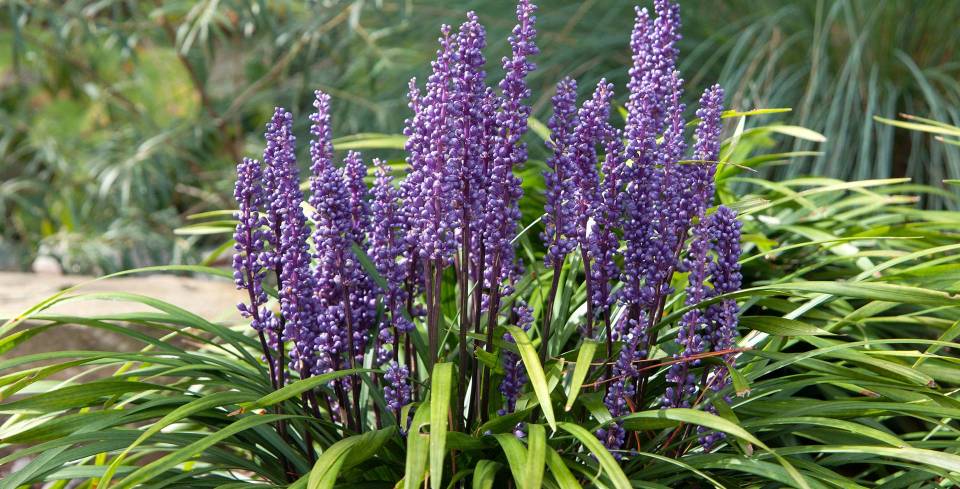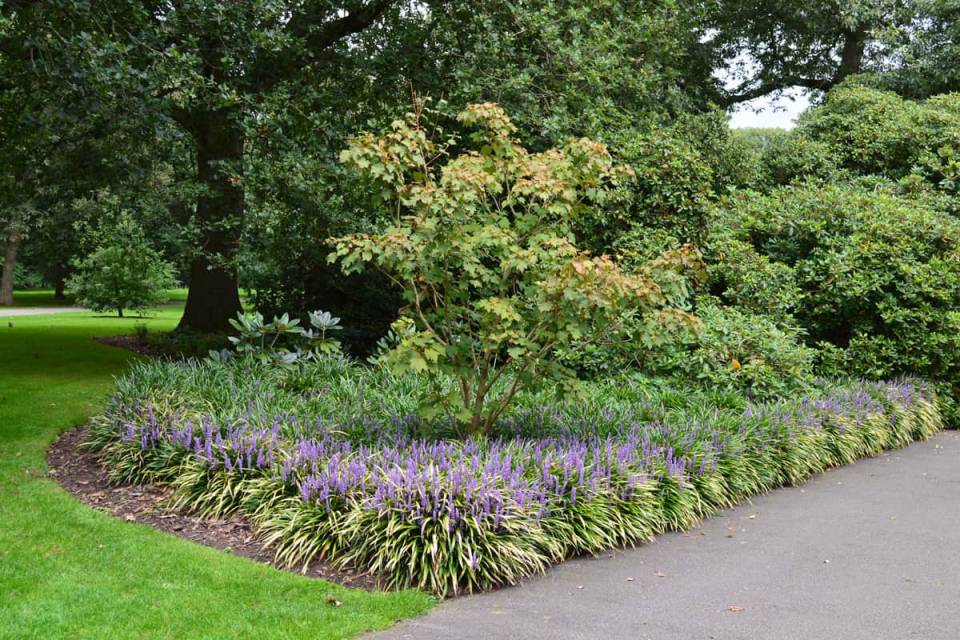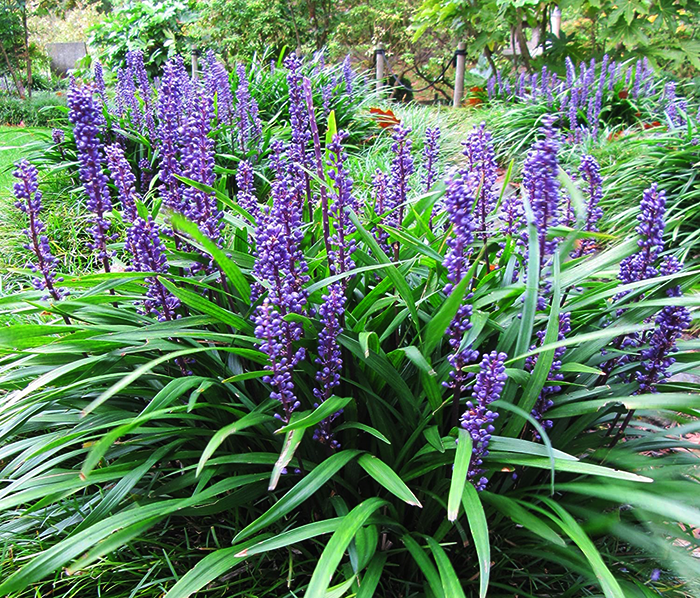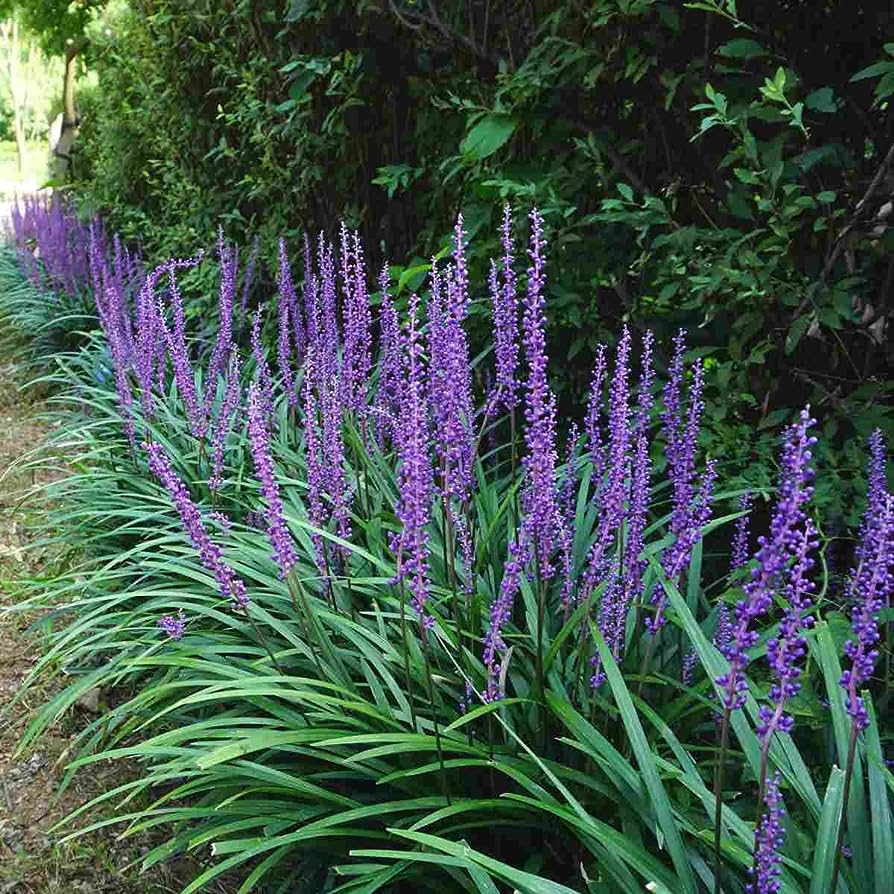Liriope: How to Plant, Grow, and Care

What is Liriope?
Liriope, often referred to as Lilyturf or Monkey Grass, is a genus of evergreen, perennial flowering plants that hail from the subtropical and temperate regions of East Asia. With its lush tufts of grass-like foliage and delicate spikes of lavender or white flowers, Liriope brings beauty and interest to any garden.
What makes Liriope particularly intriguing is its versatility. It’s often used as a ground cover, edging, or in mass plantings, where it can create a verdant carpet of greenery. It’s also highly adaptable, able to thrive in a variety of conditions, from full sun to deep shade, and tolerating a range of soil types.
But Liriope is not just a pretty face. Its dense root system makes it an excellent choice for erosion control. Moreover, it’s known to be drought-tolerant once established, making it a fantastic option for xeriscaping or low-water gardens.
Flowering from late summer into fall, Liriope produces clusters of small, bell-shaped flowers, followed by black or dark purple berries that persist into winter. These berries provide an important food source for birds during the colder months, adding another layer to Liriope’s appeal.
In summary, Liriope is a captivating plant that offers year-round interest. Whether you’re an experienced gardener or a budding green thumb, this robust and versatile plant could be a fantastic addition to your landscape.
Fast Facts About Liriope
| Attribute | Details |
|---|---|
| Country Or Region Of Origin | East Asia |
| Plant Type | Evergreen, Perennial |
| Family | Asparagaceae |
| Genus | Liriope |
| Sun Exposure | Full Sun to Deep Shade |
| Season of Interest | Late Summer to Fall |
| Water | Moderate; Drought-tolerant once established |
| Maintenance Level | Low |
| Growth Rate | Moderate |
| Height | 1-2 feet |
| Spread | 1-2 feet |
| Spacing | 1-1.5 feet |
| Soil Type | Adaptable to a variety of soils (Sand, Loam, Clay) |
| Soil pH | Acidic, Neutral, Alkaline |
| Soil Drainage | Well-drained |
| Habit/Form | Clump-forming, Ground Cover |
| Attracts | Birds (for berries) |
| Characteristics | Grass-like foliage, Spikes of lavender or white flowers, Black or dark purple berries |
| Tolerance | Drought, Erosion, Air Pollution |
| Suggested Use | Ground Cover, Mass Planting, Edging |
| USDA Plant Hardiness Zone | 4-10 |

What Are The Different Types of Liriope?
- Liriope muscari (Big Blue Lilyturf): This is a popular type of Liriope that features dark green, grass-like foliage and produces spikes of violet-blue flowers in late summer, followed by black berries.
- Liriope spicata (Creeping Lilyturf): Known for its creeping growth habit, this variety is used as a ground cover to control erosion. It has narrow, arching foliage and small lavender flowers.
- Variegated Liriope: This variety of Liriope muscari has striped leaves in a mix of green and white, creating a striking visual contrast. It also produces purple flowers.
- Silver Dragon Liriope: This is a variegated form of Liriope spicata. It has green foliage with white edges and produces light lavender flowers.
- Evergreen Giant Liriope: A taller variety that can grow up to 2-3 feet high. It has dark green, glossy leaves and produces lavender flowers.
- Monroe White Liriope: This variety stands out with its pure white flower spikes, offering a nice contrast to the common purple-flowered varieties. It’s a type of Liriope muscari.
- Royal Purple Liriope: Known for its vibrant, deep purple flowers, this variety is a type of Liriope muscari and is highly prized for its rich color.
- Emerald Goddess Liriope: This variety is known for its bright, emerald green leaves and deep blue flowers.
How to Plant and Grow Liriope
Choosing the Right Location
Liriope can tolerate full sun to deep shade, but it thrives best in part shade. Choose a location with well-drained soil. Liriope can grow in a range of soil types, including sand, loam, and clay, but it prefers a slightly acidic to neutral pH.
Preparing the Soil
Before planting, prepare the soil by removing any weeds or grass and amending it with organic matter such as compost or well-rotted manure. This will improve soil structure and fertility.
Planting Season and Tools
The ideal planting season for Liriope is spring or early fall when the weather is cooler. The tools you’ll need include a spade or trowel for digging holes, gardening gloves, and a watering can or hose.
Planting Steps
- Dig a hole twice as wide and just as deep as the root ball of your Liriope.
- Place the plant in the hole, ensuring that the top of the root ball is level with the soil surface.
- Backfill the hole with soil, firming it gently around the base of the plant.
- Water thoroughly after planting.
Watering and Feeding
Liriope has moderate water needs. Water regularly during the first growing season to establish a deep, extensive root system. Once established, reduce watering but don’t let the soil dry out completely. Feed with a general-purpose fertilizer in early spring.
Pests and Diseases
Liriope is relatively pest-free, but watch out for snails and slugs that might damage the foliage. Common diseases include anthracnose and crown rot, which can be avoided by not overwatering and ensuring good air circulation around the plants.
Pruning
Pruning is best carried out in late winter or early spring before new growth begins. With a sharp pair of garden shears, cut back the entire plant to about an inch above the ground. This might seem drastic, but it helps remove old, faded foliage and makes way for fresh, vibrant new leaves.
Make sure to clear away the trimmed leaves to prevent them from becoming a breeding ground for pests or diseases. Regularly pruning your Liriope not only keeps it looking neat and tidy but also invigorates the plant, promoting lush and healthy growth in the upcoming growing season.
Propagation
- Choose the Right Time: The best time to propagate Liriope is in early spring or fall when the plant is not actively blooming.
- Identify the Plant to Divide: Choose a healthy, mature Liriope plant that has a dense cluster of leaves.
- Dig Up the Plant: Use your garden spade to dig around the plant, taking care not to damage the roots. Lift the entire plant out of the ground.
- Divide the Plant: With your hands, gently pull apart the root ball into several sections, each with its own roots and shoots. Make sure each section has at least 3-5 shots for a good start.
- Plant the Divisions: Plant each division in a hole that’s as deep as the root ball and twice as wide. Backfill the hole with soil, firming it gently around the base of the plant. The top of the root ball should be level with the soil surface.
- Water Thoroughly: After planting, water each division thoroughly. This will settle the soil and provide the moisture needed for the roots to establish.
- Care for the New Plants: Place the potted divisions in a location with indirect light and maintain even moisture in the potting mix. Transplant them into the garden once they have developed a robust root system and show new growth.
- Monitor and Maintain: Watch for signs of growth over the next few weeks. Maintain regular watering and consider adding a slow-release fertilizer to encourage strong growth.
6 Interesting Landscape Ideas for Liriope

| Landscape Idea | Description |
|---|---|
| Ground Cover | Liriope is excellent as a ground cover due to its dense growth habit. It’s ideal for areas where grass is hard to grow or maintain |
| Border Planting | Use Liriope as a border along pathways, driveways, or flower beds. Its evergreen foliage provides year-round interest |
| Slope and Erosion Control | Plant Liriope on slopes for erosion control since its roots can help hold the soil together |
| Containers | Liriope can be grown in containers for indoor or patio use. Pair it with other plants with similar light and water needs |
| Mass Planting | Plant Liriope en masse for a dramatic effect in larger landscapes. This approach also helps to reduce weed growth |
| Under Trees or Large Shrubs | Since Liriope can tolerate shade, it’s an excellent choice for planting under trees or large shrubs where many other plants struggle |
5 Common Problems with Liriope
- Anthracnose: This fungal disease can cause reddish-brown spots along leaf margins and tips. Pruning can be an effective defense against this disease.
- Leaf and Crown Rot: This is a common issue in both nursery and landscape settings. It manifests as yellowing inner foliage.
- Slugs and Snails: These pests may chew on the foliage, but they rarely cause significant damage.
- Scale Infestation: Scale feeding can result in leaf drop and reduced growth. The first sign of a scale attack is often discoloration of the upper leaf surface.
- Crown Rot Disease: While Liriope is generally tough and versatile, crown rot disease can be a serious problem that can cause plant death.
What Does Liriope Symbolize?

| Symbolism | Explanation |
|---|---|
| Persistence and Longevity | Liriope is known for its hardiness and ability to thrive in a variety of conditions, symbolizing resilience and longevity. |
| Peace and Tranquility | The soft, grass-like foliage and gentle flowers of Liriope can be seen as a symbol of peace and tranquility. |
| Fertility and Abundance | In some cultures, the prolific nature of Liriope, with its abundant leaves and flowers, has been associated with fertility and abundance. |
| Humility | Because Liriope is often used as a ground cover and borders in gardens, it could be seen as representing humility and support. |
| Adaptability | Given its ability to grow in various soil types, light conditions, and climates, Liriope signifies adaptability and flexibility. |
Where to Buy Liriope?
7 Best Liriope Alternatives
| Liriope Alternative | Explanation |
|---|---|
| Carex pensylvanica (Pennsylvania Sedge) | An evergreen perennial native to North America, it is a great ground cover that can thrive in a variety of conditions, similar to liriope1. |
| Carex plantaginea (Plantain-Leaf Sedge) | This sedge is an excellent alternative due to its adaptability to various conditions and attractive foliage1. |
| Dryopteris cristata (Crested Wood Fern) | A shade-tolerant fern that offers an attractive, lush green look similar to liriope1. |
| Packera aurea (Golden Ragwort) | It’s a native perennial that provides bright yellow flowers in spring, offering a splash of color as well as ground cover1. |
| Chrysogonum virginianum (Green and Gold) | This semi-evergreen ground cover blooms with bright yellow flowers, providing both beauty and function2. |
| Pachysandra | Known as native pachysandra, this plant is a good alternative for liriope as it is a sturdy and attractive ground cover2. |
| Carex laxiculmis | A native to most states east of the Mississippi, it’s an excellent alternative due to its adaptability and similarity in appearance to liriope3. |

Frequently Asked Questions
1. Is the Liriope plant poisonous?
Yes, the Liriope plant is considered mildly toxic if ingested. This includes both the leaves and berries of the plant. Ingesting parts of the plant can cause symptoms such as vomiting, diarrhea, and abdominal pain. It’s important to keep this plant out of reach from pets and children who might accidentally consume it. If a pet or person has ingested Liriope and is showing signs of distress, it’s crucial to contact a healthcare professional or veterinarian immediately.
2. When to cut back Liriope?
Liriope, also known as monkey grass or lilyturf, is typically cut back in late winter or early spring (usually around late February to March in most regions) before new growth begins. This helps to remove the old, faded foliage and makes way for fresh, new growth. However, it’s important not to cut back Liriope too early in the winter, as the plant can use its old foliage to protect new shoots from potential frost damage.
3. Is Liriope the same as monkey grass?
Yes, Liriope is commonly referred to as monkey grass. It’s also known by other names such as lilyturf and blue lily turf. This grass-like flowering plant is mainly used as a ground cover or border in landscapes. However, it’s worth noting that the term “monkey grass” can also be used to refer to another similar plant, Ophiopogon or mondo grass, which can sometimes cause confusion.
4. Is Liriope an indoor plant?
Yes, Liriope, also known as Lilyturf, can be successfully grown indoors. It’s a relatively easy plant to care for and thrives when planted in a general-purpose potting mix and given a fair amount of light. While it’s often used as an outdoor ground cover, Liriope can also add a touch of greenery indoors. It prefers medium to high light indoors and relatively high humidity. Be aware that the tips of the leaves may brown in dry conditions. Also, when grown indoors, it’s prone to both scale insect and aphid infestations, so regular check-ups are important for its health.
Also read:
- Needlepoint Holly: How to Plant, Grow, and Care
- Firepower Nandina: How to Plant, Grow, and Care
- Hicks Yew Hedge: How to Plant, Grow, and Care
- Rose Creek Abelia: The Compact Evergreen Charm
- Junipers: Exploring the Many Types of This Versatile Plant
- Wisteria Vine & Tree: Tips for Growing and Planting Wisteria
- Sky Pencil Holly: The Living Exclamation Point in Your Landscape